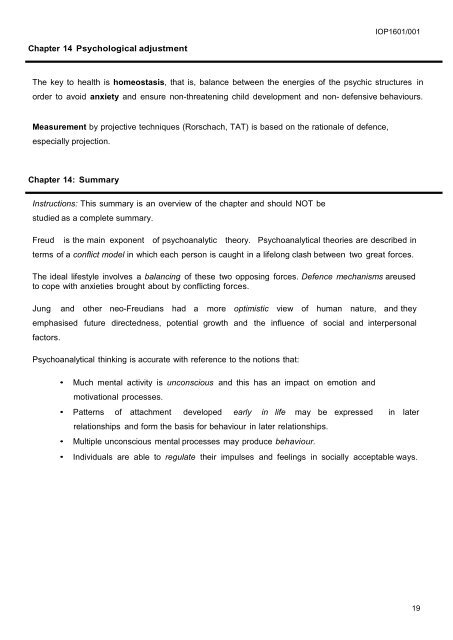IOP1601_MO001_3_2016_E
You also want an ePaper? Increase the reach of your titles
YUMPU automatically turns print PDFs into web optimized ePapers that Google loves.
<strong>IOP1601</strong>/001<br />
Chapter 14 Psychological adjustment<br />
The key to health is homeostasis, that is, balance between the energies of the psychic structures in<br />
order to avoid anxiety and ensure non-threatening child development and non- defensive behaviours.<br />
Measurement by projective techniques (Rorschach, TAT) is based on the rationale of defence,<br />
especially projection.<br />
Chapter 14: Summary<br />
Instructions: This summary is an overview of the chapter and should NOT be<br />
studied as a complete summary.<br />
Freud<br />
is the main exponent of psychoanalytic theory. Psychoanalytical theories are described in<br />
terms of a conflict model in which each person is caught in a lifelong clash between two great forces.<br />
The ideal lifestyle involves a balancing of these two opposing forces. Defence mechanisms areused<br />
to cope with anxieties brought about by conflicting forces.<br />
Jung<br />
and other neo-Freudians had a more optimistic view of human nature, and they<br />
emphasised future directedness, potential growth and the influence of social and interpersonal<br />
factors.<br />
Psychoanalytical thinking is accurate with reference to the notions that:<br />
• Much mental activity is unconscious and this has an impact on emotion and<br />
motivational processes.<br />
• Patterns of attachment developed early in life may be expressed in later<br />
relationships and form the basis for behaviour in later relationships.<br />
• Multiple unconscious mental processes may produce behaviour.<br />
• Individuals are able to regulate their impulses and feelings in socially acceptable ways.<br />
19


